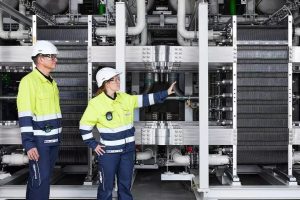Jiao Kui, a professor at Tianjin University’s School of Mechanical Engineering, and his team redesigned the proton exchange membrane fuel cell’s architecture, incorporating new components and optimizing the gas-water-electric-heat transfer routes.
The team created an ultra-thin and ultra-high power density fuel cell. They eliminated traditional gas diffusion layers and flow channels by using ultra-thin carbon nanofiber film produced by electrospinning technology and metal foam.
This progress has contributed to a 90% reduction in the thickness of the membrane electrode assembly and an 80% reduction in mass transfer losses caused by reactant diffusion, nearly doubling the volumetric power density of the fuel cell.
The research team estimates that the peak volumetric power density of the fuel cell stack using the new structure will reach 9.8 kW per liter.
Hydrogen fuel cells are regarded as one of the most promising technologies in the application of hydrogen energy. Increasing their volumetric power density, however, remains a significant technical challenge.
This breakthrough not only provides pivotal guidance for advancing PEM fuel cell technology, but it also indicates a promising leap forward in the field of clean energy.
Source: Xinhua






